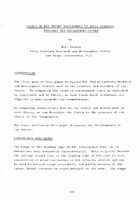| dc.contributor.author | Gordon, D. F. | |
| dc.date.accessioned | 2018-10-11T14:05:29Z | |
| dc.date.available | 2018-10-11T14:05:29Z | |
| dc.date.issued | 1971/12 | |
| dc.identifier | 75 | |
| dc.identifier.govdoc | CP-5/2 | |
| dc.identifier.uri | http://hdl.handle.net/20.500.12489/116 | |
| dc.description.abstract | The first part of this paper discusses NUC (Naval Undersea Research and Development Center) work on the accuracy and validity of ray theory. By comparing the range to convergence zones as indicated by experiment and by theory, we have found which techniques are required to make accurate ray computations. By comparing computations done by ray theory and normal-mode or wave theory, we can determine the limits to the accuracy of ray theory at low frequencies. The final portion of this paper discusses new developments in ray theory. | |
| dc.format | 9 p. : ill. ; digital, PDF file | |
| dc.language | English | |
| dc.publisher | NATO. SACLANTCEN | |
| dc.source | In: SACLANTCEN Conference Proceedings No. 5 part 2, pp. 201-209 | |
| dc.subject | Ray tracing | |
| dc.subject | Acoustic propagation | |
| dc.subject | Low frequency acoustics | |
| dc.subject | Underwater acoustics | |
| dc.subject | Sound velocity in sea water | |
| dc.subject | Computational acoustics | |
| dc.title | Status of ray theory development of Naval Undersea Research and Development Center | |
| dc.type | Papers and Articles | |
| dc.type | Conference Proceedings (CP) | |
